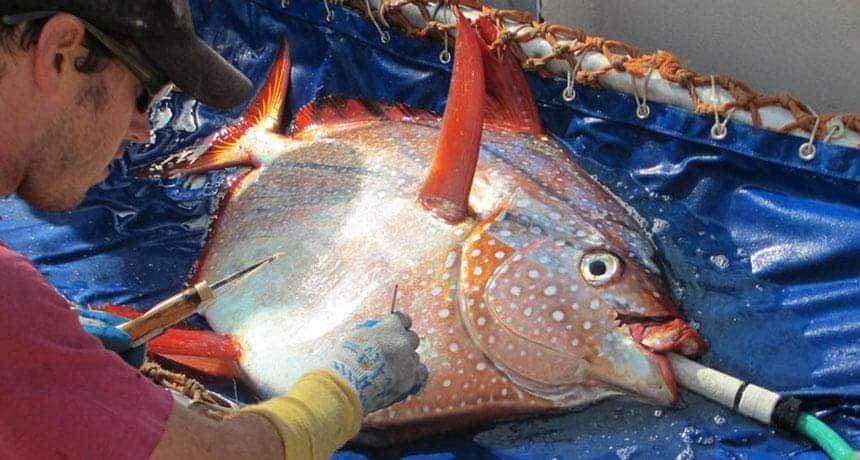Though it’s a deep ocean fish, the slender opah is actually fully warm blooded – the first of its kind discovered so far. This remarkable insight was made by accident after researchers at the National Oceanic and Atmospheric Administration dissected the fish and noticed its blue and red blood vessels were located inside the gills, rather than in the fish’s swimming muscles. Tuna or sharks, which both have the same vessels but not arranged in the same way, cool their blood once it reaches the gills for oxygen reloading. The opah’s vessels are interwoven inside the gill like a net, which means the the veins that carry warm blood away from the hot muscles are interwoven with the arteries that carry cold blood in from the gills. This makes all the difference. Running so close to each other, the warm blood from the heart heats the cold blood from the gills. This way the Opah is 5 degrees Celsius warmer than its surroundings waters!
Nicholas Wegner from the National Oceanic and Atmospheric Administration and colleagues were on research trip when they happened to catch some opah fish. While they were at it, they decided to study the fish closely – why not? They eventually found much more than they bargained for.
“That was when we realised what it was capable of,” Wegner said.
For instance, its frisbee-shape isn’t quite an indicator that this is a fast, ferocious predator. But its appearance is deceiving, as the researchers later learned after they tagged the fish with instruments.
“That’s what’s really blew my mind about this discovery,” says Wegner. “Just from looking at it, I really thought it was a slow, sluggish, deep-water fish that doesn’t do very much. But all indications are that this is a very fast fish and an active predator. We’ve put some tags on them to show that they migrate thousands of kilometres.”

The opah is as close to a full-body warm-blooded fish as science has yet discovered. Image: NOAA FISHERIES WEST COAST
Besides the net-woven blood vessels, the fish also retains heat with the help of an extra layer of fat which insulates the heart from the gills. The same applies to the pectoral muscles , where most of the heat is generated by its fins, from the surrounding water. This way, the opah’s heart, brain and muscles are all warmer than the surrounding waters, the researchers report in Science. Not even the great white shark has a warm heart.
“That’s why opah can stay at depth,” says Wegner. “These guys are specialised for living deeper than those other predators.”










